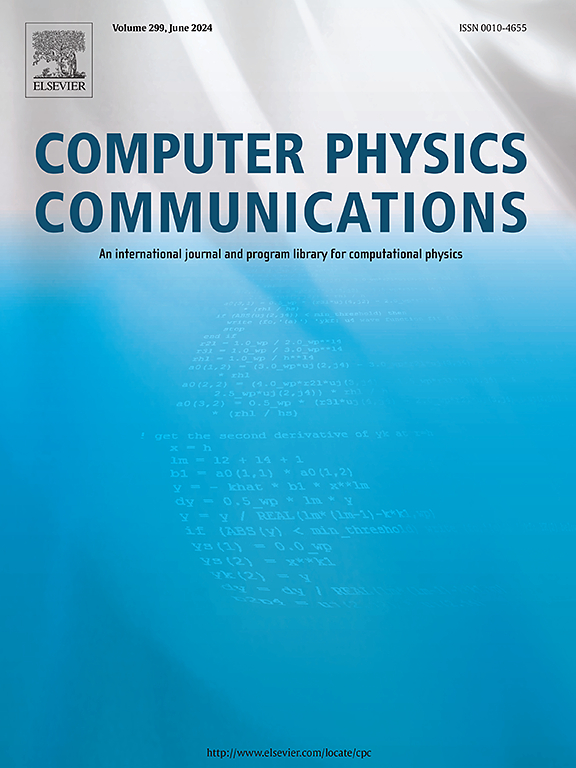基于物理感知pod的周期纳米结构从头算QEM-Galerkin模拟学习
IF 7.2
2区 物理与天体物理
Q1 COMPUTER SCIENCE, INTERDISCIPLINARY APPLICATIONS
引用次数: 0
摘要
量子纳米结构在电子、光子学、材料、药物等领域有着重要的应用。为了精确地设计和分析纳米结构和材料,总是需要模拟Schrӧdinger或Schrӧdinger-like方程。对于大型纳米结构,这些特征值问题可能需要大量的计算。一种有效的解决方法是利用固有正交分解(POD)和从头算Galerkin投影对Schrӧdinger方程进行学习。POD- galerkin将问题投影到降阶空间中,在模拟中以第一原理为指导的POD基表示电子波函数(WFs)。为了最大限度地减少训练工作量并增强POD-Galerkin在更大结构中的鲁棒性,先前提出了量子元方法(QEM),该方法将纳米结构划分为通用量子元。然后,更大的纳米结构可以由经过训练的通用量子元素构建,每个量子元素都由pod -伽辽金模型表示。本文对多元素量子点(QD)结构中的QEM-Galerkin进行了深入的研究,探讨了进一步提高QEM-Galerkin训练效果和仿真精度和效率的方法。为了进一步提高计算速度,在QEM-Galerkin模拟中还研究了周期势的POD基和傅立叶基。结果表明,从效率和准确性两方面考虑,POD势基优于傅立叶势基。总的来说,QEM-Galerkin在多元素QD结构的直接数值模拟中提供了超过2阶的计算加速,并且在包含更多元素的结构中观察到更多的改进。本文章由计算机程序翻译,如有差异,请以英文原文为准。
Physics-aware POD-based learning for Ab initio QEM-Galerkin simulations of periodic nanostructures
Quantum nanostructures offer crucial applications in electronics, photonics, materials, drugs, etc. For accurate design and analysis of nanostructures and materials, simulations of the Schrӧdinger or Schrӧdinger-like equation are always needed. For large nanostructures, these eigenvalue problems can be computationally intensive. One effective solution is a learning method via Proper Orthogonal Decomposition (POD), together with ab initio Galerkin projection of the Schrӧdinger equation. POD-Galerkin projects the problem onto a reduced-order space with the POD basis representing electron wave functions (WFs) guided by the first principles in simulations. To minimize training effort and enhance robustness of POD-Galerkin in larger structures, the quantum element method (QEM) was proposed previously, which partitions nanostructures into generic quantum elements. Larger nanostructures can then be constructed by the trained generic quantum elements, each of which is represented by its POD-Galerkin model. This work investigates QEM-Galerkin thoroughly in multi-element quantum-dot (QD) structures on approaches to further improve training effectiveness and simulation accuracy and efficiency for QEM-Galerkin. To further improve computing speed, POD and Fourier bases for periodic potentials are also examined in QEM-Galerkin simulations. Results indicate that, considering efficiency and accuracy, the POD potential basis is superior to the Fourier potential basis even for periodic potentials. Overall, QEM-Galerkin offers more than a 2-order speedup in computation over direct numerical simulation for multi-element QD structures, and more improvement is observed in a structure comprising more elements.
求助全文
通过发布文献求助,成功后即可免费获取论文全文。
去求助
来源期刊

Computer Physics Communications
物理-计算机:跨学科应用
CiteScore
12.10
自引率
3.20%
发文量
287
审稿时长
5.3 months
期刊介绍:
The focus of CPC is on contemporary computational methods and techniques and their implementation, the effectiveness of which will normally be evidenced by the author(s) within the context of a substantive problem in physics. Within this setting CPC publishes two types of paper.
Computer Programs in Physics (CPiP)
These papers describe significant computer programs to be archived in the CPC Program Library which is held in the Mendeley Data repository. The submitted software must be covered by an approved open source licence. Papers and associated computer programs that address a problem of contemporary interest in physics that cannot be solved by current software are particularly encouraged.
Computational Physics Papers (CP)
These are research papers in, but are not limited to, the following themes across computational physics and related disciplines.
mathematical and numerical methods and algorithms;
computational models including those associated with the design, control and analysis of experiments; and
algebraic computation.
Each will normally include software implementation and performance details. The software implementation should, ideally, be available via GitHub, Zenodo or an institutional repository.In addition, research papers on the impact of advanced computer architecture and special purpose computers on computing in the physical sciences and software topics related to, and of importance in, the physical sciences may be considered.
 求助内容:
求助内容: 应助结果提醒方式:
应助结果提醒方式:


